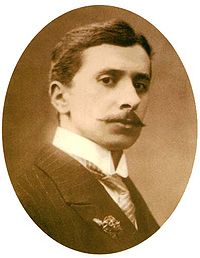
Back ماتيو كاراجيالي Arabic ماتيو كاراجيالى ARZ Mateiu Ion Caragiale Czech Mateiu Caragiale German Mateiu Caragiale Estonian Mateiu Caragiale French מאטיי קאראג'אלה HE Mateiu Caragiale Italian Matthaeus Caragiale Latin Mateiu Ion Caragiale Polish
Mateiu Caragiale | |
|---|---|
 | |
| Born | March 25, 1885 Bucharest, Romania |
| Died | January 17, 1936 (aged 50) Bucharest |
| Occupation | Poet, short story writer, novelist, visual artist, heraldist, civil servant, journalist |
| Period | 1912–1936 |
| Genre | lyric poetry, fantasy, satire, detective fiction, memoir |
| Literary movement | Symbolism, Decadence, Parnassianism, Modernism, Gândirea |
Mateiu Ion Caragiale (Romanian: [maˈtej iˈon karaˈdʒjale]; March 25 [O.S. March 12] 1885 – January 17, 1936), also credited as Matei or Matheiu, or in the antiquated version Mateiŭ,[1][2] was a Romanian poet and prose writer, best known for his novel Craii de Curtea-Veche, which portrays the milieu of boyar descendants before and after World War I. Caragiale's style, associated with Symbolism, the Decadent movement of the fin de siècle, and early modernism, was an original element in the Romanian literature of the interwar period. In other late contributions, Caragiale pioneered detective fiction locally, but there is disagreement over whether his work in the field produced a complete narrative or just fragments. The scarcity of writings he left is contrasted by their critical acclaim and a large, mostly posthumous, following, commonly known as mateists.
Also known as an amateur heraldist and graphic artist, the young Caragiale published his works sporadically, seeking instead to impose himself in politics and pursuing a career in the civil service. He was associated with the Conservative-Democratic Party, and then the People's League, and ultimately raised controversy by supporting the Central Powers during their occupation of Romania. He afterwards focused on literature, and, during the late 1920s and early 1930s, published most of his prose texts in the magazine Gândirea.
The illegitimate and rebellious child of influential playwright Ion Luca Caragiale, he was the half-brother of Luca Caragiale, an avant-garde poet who died in 1921, and the posthumous son-in-law of author Gheorghe Sion. Mateiu Caragiale was loosely affiliated with Romanian Symbolism, a figure noted for his dandyism, eccentricity and Bohemianism, and, for much of his life, a regular presence in the intellectual circle formed around Casa Capșa restaurant. His associates included the controversial political figure Alexandru Bogdan-Pitești, cultural animator Mărgărita Miller Verghy, and poet Ion Barbu, who was also one of his most dedicated promoters.
- ^ Ș. Cioculescu (p. 360) criticizes the pronunciation [maˈteju]: "Deceived by the old orthography, with its final short u, Mateiu, several young people pronounce the final vowel, as if part of a diphthong: Ma-te-iu."
- ^ Sorin Antohi, "Romania and the Balkans. From Geocultural Bovarism to Ethnic Ontology", in Tr@nsit online, Institut für die Wissenschaften vom Menschen, Nr. 21/2002